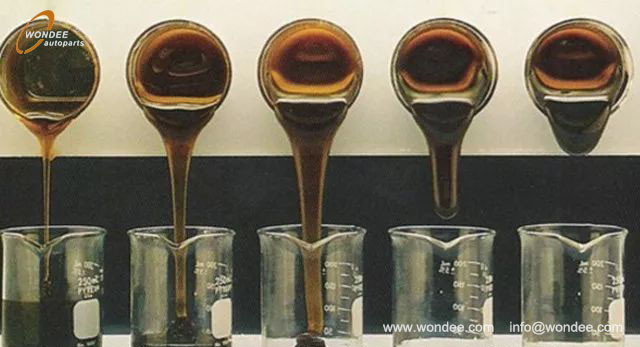Views: 0 Author: Wondee Autoparts Publish Time: 2024-05-11 Origin: Wondee Autoparts








The oil drum will be clearly marked with words similar to 5W-30, commonly including 5W-40, 0W-20, etc., which represent the viscosity of the engine oil, that is, whether the oil is thick or thin. We don't need to choose the viscosity of the engine oil when we go to the 4S store for maintenance. We just need to choose fully synthetic or semi synthetic, and choose the brand of engine oil. Every car has a standard viscosity requirement, and the oil used in the 4S store is original and must meet the requirements for use in this car. After the warranty period, many people no longer maintain the car at the 4S dealership, but instead opt for maintenance outside, with a wide range of oil options available. Brands can be freely chosen, but the viscosity of the engine oil must not be chosen incorrectly as it can have a negative impact on the engine. Next, let me explain what the numbers for engine oil viscosity mean.

The number before W refers to the quality of low-temperature fluidity. The smaller the number, the better the low-temperature fluidity, while the larger the number, the worse the low-temperature fluidity. The size of the number is also an important indicator to distinguish between winter engine oil and summer engine oil. Generally, a number of 10 indicates summer engine oil, while 5 and 0 indicate winter engine oil. The number 5 indicates that it can be used normally in an environment below minus 30 degrees Celsius, while the number 0 indicates that it can be used in an environment below minus 35 degrees Celsius. The most common engine oils used in cars are 5 and 0, also known as seasonal engine oil, which can be used in both winter and summer. 5 can basically adapt to most parts of China, and in extremely cold areas in Northeast China, 0 should be used. Therefore, it can be seen that the number before W should be selected based on the ambient temperature of the vehicle's use. The main function of low-temperature fluidity is to ensure smooth starting of the vehicle and one or two minutes after starting. Good fluidity can also ensure lubrication of various components after starting.

The number after W refers to the kinematic viscosity at 100 degrees, which is the kinematic viscosity when the car is hot. The higher the number, the greater the viscosity, which is the thicker the oil. The viscosity of engine oil usually refers to the number after W. Because the temperature of the engine oil rises a few minutes after the vehicle is started, it is not related to the number before W, but only to the number after W. If the number is large, the engine oil will still be thick when the car is hot, but if the number is small, it will be very thin when the car is hot. The common numbers are 20, 30, and 40, each thicker than the other.

The thinner the engine oil, the better its high-temperature fluidity. The thinner the oil film formed between moving parts, the smaller the resistance, which is conducive to reducing fuel consumption. The engine oil can also better dissipate heat. Generally, the viscosity of engine oil used in Japanese cars is relatively low, with more numbers after 20. The thicker the oil, the poorer its high-temperature fluidity, the thicker the oil film formed between moving parts, the greater the resistance, and it will be relatively more fuel-efficient. However, there is an advantage, as the oil film is thick, it provides better protection for the engine at high speeds and heavy loads, and the oil itself has better sealing properties.

Knowing the meaning of engine oil viscosity, what viscosity grade should one choose for their car? The same viscosity as the original car is the best. If you don't know what the original car is, you can refer to the maintenance manual. If the repair shop does not have the same viscosity as the original car, then only the one with higher viscosity than the original car can be selected, not the one with lower viscosity. For example, if the original car is 5W-30, you can choose 5W-40 or 0W-40, but you cannot choose 5W-20. The original car requires high oil viscosity. If a low viscosity is selected, it will not meet the lubrication conditions of the engine and increase engine wear. Choosing a higher one will increase fuel consumption at most, but it will not affect the lubrication of the engine. If the car is relatively old, or if you drive aggressively and frequently step on the accelerator, the engine will run at high load, which can also increase the viscosity of the oil.
From: WONDEE Autoparts
2024-5-11
How Semi-Trucks Changed Freight Forever: A Century of Innovation
Will airbags open normally in the event of a collision when driving without wearing seat belts?
How do you know if the car shock absorber is broken? Must it be replaced in pairs?
It's best to throw away these car supplies as soon as possible
Can you use child locks on cars? How many do you know about the hidden functions on cars?
Do you know how to turn left in the waiting area? When should I enter?